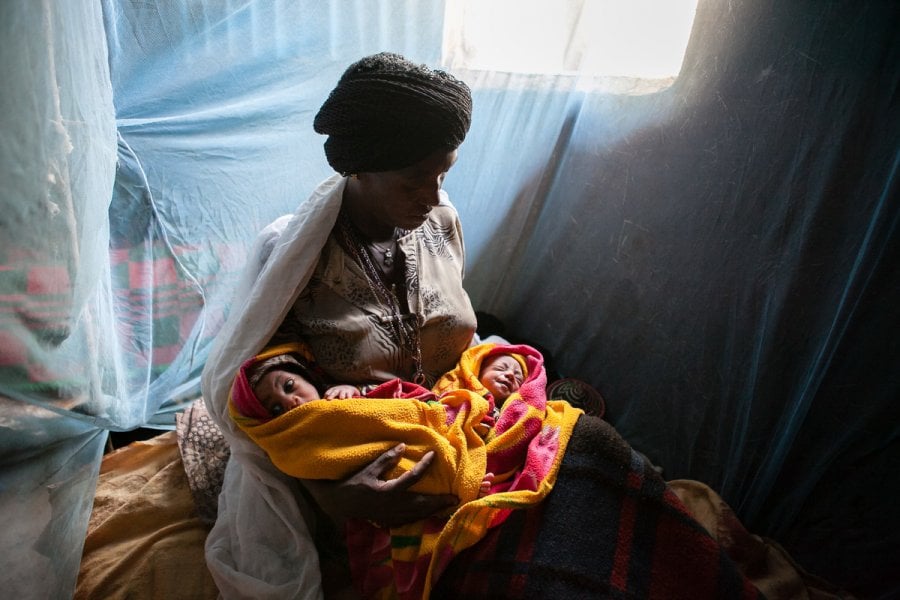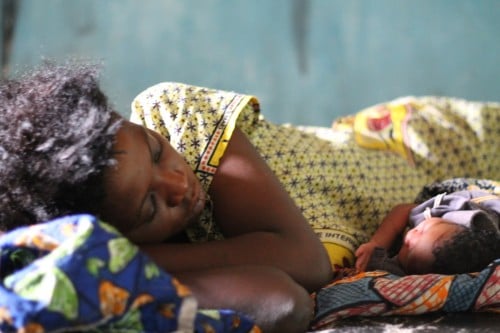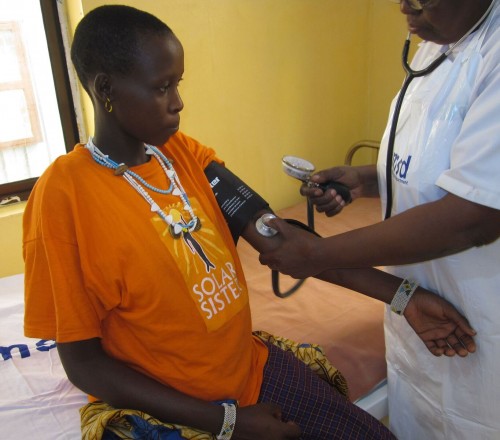
Malaria Infection and Pregnancy: Tackling a Unique Public Health Challenge
Over the past 20 years, members of the Malaria Centre at the London School of Hygiene & Tropical Medicine have been at the forefront of tackling the unique public health challenge of malaria infection during pregnancy. Research today builds on knowledge that extends back at least as far as Hippocrates, when he observed that pregnant women were vulnerable to life-threatening fevers.1 Alphonse Laveran, aided by crude microscopy in the late 19th Century, furthered our understanding today about the vulnerabilities of pregnant women to malaria infection when he reported that women who experienced symptoms associated with Plasmodium falciparum infection had higher placental parasite densities than mothers who had been free of malarial symptoms throughout their pregnancies.2 We now know that P. falciparum, the most pernicious of malaria species that infects humans, actually behaves uniquely in pregnant women. Erythrocytes that have been parasitised may bind to and accumulate in placental tissues. This means that present-day diagnostic tests relying merely on a pin-prick of blood from peripheral circulation may fail to detect maternal infection and compromised placental function attributable to malaria.
In 1986, the World Health Organization (WHO) first recommended the provision of chemoprophylaxis to pregnant women living in malaria-endemic areas. During antenatal visits, women were given sachets of either chloroquine or pyrimethamine for weekly self-administration.3 However, compliance with these two regimens proved difficult,4,5 and the spread of P. falciparum resistance to chloroquine and, separately, to pyrimethamine undermined their protective effect.4-6 A new approach was needed.
In 1993, Malawi became the first country to adopt a national strategy of directly-observed chemoprevention using sulphadoxine-pyrimethamine (SP) among pregnant women during scheduled antenatal care visits from the second trimester to delivery.7 This was designed to overcome the challenge of compliance and to be more efficacious. A clinical trial8 in Kenya9 and operational experience10 from Malawi11 was sufficient for the WHO to recommend intermittent preventive treatment of malaria in pregnancy (IPTp) using SP. As designed, the intervention protects against asymptomatic parasitaemia, peripheral and placental infection that may be present at the time of dosing while, separately, shielding against future malaria infections that may occur after dosing and before the next antenatal care visit.12 At present, 36 countries worldwide that have an IPTp-SP policy, 35 of which are in sub-Saharan Africa13 and researchers of the Malaria Centre have spearheaded efforts to scale up coverage.14
While trying to expand the uptake of IPTp-SP, Malaria Centre researchers have also found that several parasite mutations associated with decreased SP sensitivity vary geographically in sub-Saharan Africa by type and prevalence. Epigenetic analyses suggested there were three foci in East Africa where parasite populations acquired the additional mutation of Pfdhps A581G to become ‘super resistant’15 to SP.
In the face of growing parasite resistance to SP, clinical trials to identify alternatives to SP for use in IPTp were led by researchers from the Malaria Centre, and evaluated screen-and-treat approaches with the aim of replacing IPTp altogether.16 More efficacious antimalarial treatments have either been too poorly tolerated as IPTp or, surprisingly, failed to demonstrate superiority against SP when considering overall adverse pregnancy outcomes. A puzzling outcome, as SP is clearly sub-optimal in clearing malaria infections.
Evidence from Malaria Centre researchers helped to explain what might be happening. Meta-regression analysis of IPTp-SP trials showed there was no threshold of malaria transmission intensity below which two or more doses of IPTp-SP no longer protects against the incidence of low birthweight.17 The absence of a cut off suggests that IPTp-SP contributes to more than just protecting against malaria. New evidence indicates that SP is indeed protective against adverse pregnancy outcomes among women with curable sexually transmitted and reproductive tract infections (STIs/RTIs) as well as malaria.18 While it is unlikely that sulphadoxine has curative effects on STIs/RTIs, it is possible that its broad spectrum antimicrobial potency helps reducing bacterial and parasitic loads in expecting mothers. This may not only allow them to manage their infections better, but also reduce circulation of maternal inflammatory triggers, leading to protection against preterm birth and low birthweight.
Despite this encouraging evidence about IPTp-SP, the intervention remains sub-optimal against malaria infections and is not indicated for the prevention or treatment of STIs/RTIs. Malaria Centre researchers are now investigating combination treatments with the hope of offering better protection against the dual burden of malaria and curable STIs/RTIs in pregnancy, a critical public health issue. Indeed, the prevalence of curable STIs/RTIs – when considered collectively – is likely higher than malaria infection,19 and recent evidence from Zambia suggests that malaria and curable STI/RTI co-infection is more common than malaria or curable STIs/RTIs alone.20
References
- Sprengell CF. The Aphorisms of Hippocrates and the Sentences of Celsus: With Explanations and References By Hipócrates, Aulo Cornelio Celso. London: Printed by R Bonwick, W Freeman, Tim Goodwin, John Withoe, Matt Wotton, John Nickolson, Samuel Manship, Richard Parker, Benj. Tooke and Ralph Smith; 1708.
- Laveran A. Traité des fièvres palustres avec la description des microbes du paludisme. 1st ed. Paris: Octave Doin; 1884.
- World Health Organization. WHO Expert Committee on Malaria, Technical Report Series 1986; Report 18(735): 57-9.
- Steketee RW, Wirima JJ, Slutsker L, Heymann DL, Breman JG. The problem of malaria and malaria control in pregnancy in sub-Saharan Africa. Am J Trop Med Hyg 1996; 55(1 Suppl): 2-7.
- World Health Organization. Antimalarial drug policies: data requirements, treatment of uncomplicated malaria and management of malaria in pregnancy. Report of an informal consultation. Geneva: World Health Organization, 1994.
- Sirima SB, Sawadogo R, Moran AC, et al. Failure of a chloroquine chemoprophylaxis program to adequately prevent malaria during pregnancy in Koupela District, Burkina Faso. Clin Infect Dis 2003; 36(11): 1374-82.
- Brabin BJ, Verhoeff FH, Kazembe P, Chimsuku L, Broadhead R. Antimalarial drug policy in Malawi. Annals of Tropical Medicine and Parasitology 1997; 91(Supplement 1): 113-6.
- Parise ME, Ayisi JG, Nahlen BL, Schultz LJ, Roberts JM, Misore A. Efficacy of sulfadoxine-pyrimethamine for prevention of placental malaria in an area of Kenya with a high prevalence of malaria and human immunodeficiency virus infection. Am J Trop Med Hyg 1998; 59.
- Shulman CE, Dorman EK, Cutts F, et al. Intermittent sulphadoxine-pyrimethamine to prevent severe anaemia secondary to malaria in pregnancy: a randomised placebo-controlled trial. Lancet (London, England) 1999; 353(9153): 632-6.
- Verhoeff FH, Brabin BJ, Chimsuku L, Kazembe P, Russell WB, Broadhead RL. An evaluation of the effects of intermittent sulfadoxine-pyrimethamine treatment in pregnancy on parasite clearance and risk of low birthweight in rural Malawi. Ann Trop Med Parasitol 1998; 92(2): 141-50.
- Schultz LJ, Steketee RW, Macheso A, Kazembe P, Chitsulo L, Wirima JJ. The efficacy of antimalarial regimens containing sulfadoxine-pyrimethamine and/or chloroquine in preventing peripheral and placental Plasmodium falciparum infection among pregnant women in Malawi. Am J Trop Med Hyg 1994; 51(5): 515-22.
- World Health Organization. A Strategic Framework for Malaria Prevention and Control During Pregnancy in the Africa Region: World Health Organization Regional Office for Africa; 2004.
- World Health Organization. World Malaria Report 2012. Geneva: World Health Organization; 2012.
- Chico RM, Dellicour S, Roman E, et al. Global Call to Action: maximize the public health impact of intermittent preventive treatment of malaria in pregnancy in sub-Saharan Africa. Malaria journal 2015; 14: 207.
- Naidoo I, Roper C. Mapping 'partially resistant', 'fully resistant', and 'super resistant' malaria. Trends Parasitol2013.
- Desai M, Hill J, Fernandes S, et al. Prevention of malaria in pregnancy. The Lancet Infectious diseases 2018; 18(4): e119-e32.
- Chico RM, Cano J, Ariti C, et al. Influence of malaria transmission intensity and the 581G mutation on the efficacy of intermittent preventive treatment in pregnancy: systematic review and meta-analysis. Tropical medicine & international health : TM & IH 2015; 20(12): 1621-33.
- Chico RM, Chaponda EB, Ariti C, Chandramohan D. Sulfadoxine-pyrimethamine exhibits dose-response protection against adverse birth outcomes related to malaria and sexually transmitted and reproductive tract infections. Clinical Infectious Diseases 2017; 64(8): 1043-51.
- Chico RM, Mayaud P, Ariti C, Mabey D, Ronsmans C, Chandramohan D. Prevalence of Malaria and Sexually Transmitted and Reproductive Tract Infections in Pregnancy in Sub-Saharan Africa: A Systematic Review. Journal of the American Medical Association (JAMA) 2012; 307(19): 2079-86.
- Chaponda EB, Chico RM, Bruce J, et al. Malarial infection and curable sexually transmitted and reproductive tract infections among pregnant women in a rural district of Zambia. American Journal of Tropical Medicine and Hygiene 2016; 16-0370: In press (pub online 26 September 2016).
LSHTM's short courses provide opportunities to study specialised topics across a broad range of public and global health fields. From AMR to vaccines, travel medicine to clinical trials, and modelling to malaria, refresh your skills and join one of our short courses today.


